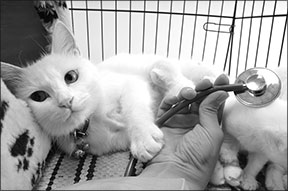Chances are that your cat will face a surgical procedure at least once during his lifetime if he hasn’t already. Happily, the nature of veterinary surgery is changing, which may mean that your cat’s next encounter could differ considerably.

bigstock
288
“Better anesthetic protocols, better postoperative pain relief and innovative surgical techniques have broadened the veterinarian’s ability to successfully do surgery on a wider variety of animals, such as older animals, very ill animals and animals with multiple health problems,” says James A. Flanders, DVM, DACVS, Medical Director of the Cornell University Hospital for Animals at the Cornell University College of Veterinary Medicine.
“Minimally invasive surgery is now available at some veterinary practices,” he says. “Advances in imaging techniques allow veterinarians to have a better idea of the disease state of an animal prior to surgery, so they can have a more informed conversation with owners before surgery.”
Despite such changes, certain aspects of surgery remain the same. Here’s what you can expect before, during and after your cat undergoes a surgical procedure.
First, the Consultation. The process begins when the veterinarian confers with you. “I always recommend that the pet owner knows why we are recommending a particular procedure, and I want them to be fully informed about the expected outcome, potential complications and possible risks,” Dr. Flanders says. “These parameters vary tremendously depending on the procedure and the condition of the pet. Each owner —and each animal — is unique.”
Dr. Flanders also makes sure that owners understand the cost of the actual surgery and testing such as blood work and imaging; anesthesia, antibiotics and intravenous fluids; and post-surgical care such as pain medication and hospitalization.
Next, Blood Tests. For the veterinarian and clinic, pre-surgical work will likely focus on blood tests to identify any problems that might complicate the surgery, especially with respect to the anesthetic. The veterinarian may also order an X-ray or ultrasound.
The task for the owner is to withhold food and water from the cat for at least several hours before the procedure. “Sedatives and anesthetic drugs can make pets nauseous,” Dr. Flanders says. “If the cat happens to vomit during the recovery from anesthesia, he may inhale the vomitus and get aspiration pneumonia, a very serious condition. If the stomach is empty, the chance of severe aspiration pneumonia is lessened.”
Afterward, Recovery. A surgeon usually contacts the owner immediately after the procedure to explain how it went, but that’s not always the case. “If I find something very unexpected during the surgery, and I feel the owner needs to know immediately in order to make a decision, I will scrub out of surgery and call them,” says
Dr. Flanders. One example: discovery of an advanced cancer. If all has gone as expected, emphasis shifts to immediate and long-term recovery. “Depending on the type of anesthesia, condition of the patient and duration of the procedure, cats can take anywhere from five minutes to several hours to completely recover,” says Dr. Flanders.
Reactions also vary. “Initially, a cat may be uncoordinated and may not recognize his surroundings or even his owners,” Dr. Flanders says. “He may not gain his normal appetite or thirst until the next day. And he may not have a bowel movement for several days.”
Age is another factor. “In general, young animals recover more rapidly than older animals,” says Dr. Flanders. “Young pets have faster metabolic rates, so they metabolize drugs faster.”
Still another variable is where recovery takes place. For most feline patients, home is usually the ideal best place — but not always. “Sometimes pets need to stay in the hospital to receive additional support such as special intravenous fluid therapy, post-operative catheterization, special drainage procedures, specialized bandage changes or continuous monitoring and support for a critical patient by a trained nursing staff,” says Dr. Flanders.
In any case, managing post-surgical pain optimizes recovery. “The veterinarian now has many choices of anti-pain drugs specifically designed for pets that can be dispensed before, during and after surgery,” says Dr. Flanders. “Many of these drugs are similar to human pain medications.”
Modern veterinary medicine has helped reduce the risks and stress of cats’ surgical treatments. Knowing what to expect can further lessen the stresses for owner and cat alike. ❖



